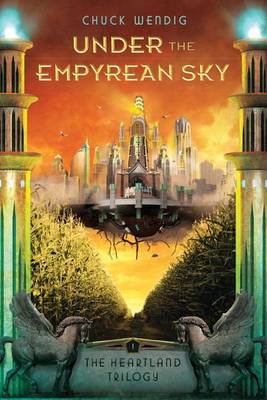Reviewed by Katie King on
This book simply ASTOUNDED me. I went into it with pretty low expectations, but Wendig really delivers. The book starts out with a throwdown between Cael and Boyland Barnes Jr., Cael's archrival and the mayor's son. Both Cael and Boyland are scavengers, meaning they scour the Heartland (Earth) for artifacts and interesting things that the community can sell to the cities in the sky, the Empyrean. Boyland has quite the reputation as a scavenger because he plays dirty (and being the mayor's son helps with this) , thus the rivalry. Boyland's dirty tactics are illustrated in the first chapter.
The amazing part of this book is how detail-oriented the plot and world are for the page count. Within the first few chapters we get a clear picture of the world Cael lives in. Basically the Earth (Heartland) is completely ruined for any agriculture except this crazy, scary hybrid strain of corn (the corn is very creepy). As a result, only a few towns exist solely to grow the corn and keep it somewhat under control with chemicals. This had led to numerous problems such as lack of resources and eating the chemically corn, stillbirths, Blight (where body parts are made of vines), tumors, deformities, etc. Think consequences of exposure to radiation. Meanwhile, anyone who really matters is living in the cities in the sky - the Empyrean; large, floating flotillas of rooms and passageways that make up dozens of cities. Naturally there is some discontent from those in the Heartland. All that barely scratches the surface.
Another strong point for Under the Empyrean Sky is how well written it is. Most of the characters, even secondary characters, have more than just one face. Even a character that you may think you have completely figured out could still surprise you in the ending. For example, (show spoiler)[Gwennie is betrothed to Boyland, but is in love with Cael. When she is taken to the Empyrean, Cael tries everything to get her back to the Heartland, but so does Boyland. Boyland isn't just a dumb brute. When Gwennie sees this, she is actually a little at war with herself over feeling sympathy for him. Gwennie may have to make a real choice in the future] . As late as the last 10 pages, I was STILL surprised. It was crazy!
The only drawback to this book was that maybe it had a little too much going on in one book. I really like everything that happened in the last 50%, but to me it felt like it had multiple climaxes. Everything goes haywire, then it calms down, then it's all crazy again, then it calms down, and then it's crazy again. To be honest, it was too much of a rollercoaster of emotion. Nevertheless, I immediately bought the sequel and eagerly wait to see what happens to Cael & company!
Reading updates
- Started reading
- 30 December, 2014: Finished reading
- 30 December, 2014: Reviewed

